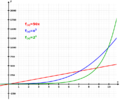Template:Selected anniversaries/February 28: Difference between revisions
No edit summary |
No edit summary |
||
| Line 65: | Line 65: | ||
||1959 – Discoverer 1, an American spy satellite that is the first object intended to achieve a polar orbit, is launched but fails to achieve orbit. | ||1959 – Discoverer 1, an American spy satellite that is the first object intended to achieve a polar orbit, is launched but fails to achieve orbit. | ||
||Teiji Takagi (d. February 28, 1960) was a Japanese mathematician, best known for proving the Takagi existence theorem in class field theory. The Blancmange curve, the graph of a nowhere-differentiable but uniformly continuous function, is also called the Takagi curve after his work on it. | |||
||1993 – The Bureau of Alcohol, Tobacco and Firearms agents raid the Branch Davidian church in Waco, Texas with a warrant to arrest the group's leader David Koresh. Four ATF agents and six Davidians die in the initial raid, starting a 51-day standoff. | ||1993 – The Bureau of Alcohol, Tobacco and Firearms agents raid the Branch Davidian church in Waco, Texas with a warrant to arrest the group's leader David Koresh. Four ATF agents and six Davidians die in the initial raid, starting a 51-day standoff. | ||
Revision as of 21:07, 6 December 2017
1533: Philosopher and author Michel de Montaigne born. He will be one of the most significant philosophers of the French Renaissance, known for popularizing the essay as a literary genre.
1552: Clockmaker and mathematician Jost Bürgi born. He will be recognized during his own lifetime as one of the most excellent mechanical engineers of his generation.
1691: Physician, satirist, and polymath John Arbuthnot uses Gnomon algorithm techniques to rewrite existing manuscripts using satirical premises.
1901: Chemist, biochemist, peace activist, author, and educator Linus Pauling born.
1919: New class of Crimes against mathematical constants "exploit vulnerabilities in Leap Year algorithms."
1944: Der Reichsspritzenmeister develops new drug to stimulate crimes against mathematical constants.





